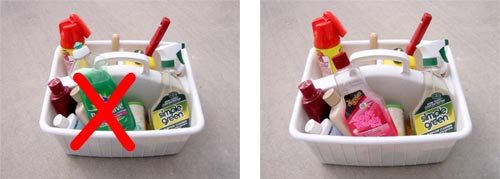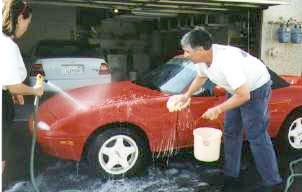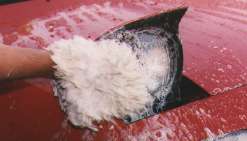Washing
Start by THOROUGHLY rinsing the car. As we said in rule #1, use lots of water and a
gentle stream to avoid scratches. Excessive water pressure will cause
the dirt to grind at the surface. Some detailers prefer to let the water flow freely
out of the hose without the benefit of a nozzle.

Use a detergent designed specifically for car washing. Don't use common
dish washing detergent, as it is too strong and will remove the wax you want to keep.
There really isn't a lot to washing a car; simply mix detergent according to the
manufacturers' directions, dip your sponge or mit into the bucket and have at it.
There are a few guidelines to follow however:
|
- Use generous amounts of water/detergent. On this Miata, which is a relatively small
car, we'll use three or four buckets. On a medium sized car, such as a Honda Accord, five or six
buckets will do the job. When the bucket gets down to about one-third fill, empty it, give it a quick rinse and refill with detergent/water.
- When you wash a car, do it in sections. Start with the roof, which will make rinsing
easier. Then do other sections, such as the front fender, door, rear fender and so on,
rinsing thoroughly in between. Always rinse soon after applying so a soap film does
not develop. Do not suds up the entire car and then rinse; some of the soap will dry
and a film like substance will remain.
- After washing, rinse the entire car just to be sure all the soap is cleared away. Don't
forget the nooks, crannies and crevices where soap can hide.
- If the car is particularly dirty, wash it twice. The first washing will take care of
the majority of the dirt and the second will complete the job. Some car enthusiasts
will wash twice as part of their routine.
- Avoid scratches by using two buckets; one will have your normal car wash detergent, the other will be just water. When you are finished sudsing up a particular area, rinse the wash mit/sponge in the plain water. This will keep scratch causing dirt particles from revisiting the surface of your car. Another approach is to rinse off with your hose the wash mit/sponge before dipping it into the car wash detergent.


- Car washing will go a lot quicker if two people are on the job. One will do the sudsing,
while the other follows close behind with the rinsing hose.
|
Drying
Dry thoroughly, using a generous supply of the softest towels you can find. Fold the
towel into a manageable square and turn it over or unfold it frequently to take
advantage of its entire surface. Used towels seem to work best, probably because
repeated washings have softened them. Bath towels work well, although it may be more
practical to cut them in half.
Microfiber Towels
Microfiber towels are a recent development and have gained quick acceptance amongst both professional and amateur detailers.
|
As their name implies, Microfiber towels are made up of extremely fine fibers about 100 times smaller than human hair. They feature soft surfaces that accommodate the "avoid scratches at all costs" mantra of a quality detailing job. Unlike cotton, which is a natural fabric, Microfiber is synthetically manufactured using two basic fibers, Polyester and Polyamide. Microfiber towels used for drying are "split", a process which allows them to "hook" up dirt and other undesireable items, giving them their cleaning properties. The same splitting process gives microfiber towels their water absorbant characteristics. They are excellent for drying a car after a washing session and can absorb seven times their weight in water.
|
Wash microfiber towels with small amounts of liguid detergent; do not use powder as it is possible for undissolved scratch causing powder particles to remain in the towel. Do not use bleach or fabric softeners. Air drying is preferred as intense heat is bad for microfiber towels.
Drying is best accomplished as a two part process. The first time you will get rid of
most of the water and the second pass will complete the job. As with rinsing, do not
forget the various nooks and crannies which can trap water.
Miscellaneous Notes:
- We do not recommend using a chamois, since they can trap dirt and cause scratches. They also have a tendency to "pull" the wax off.
- If possible, do not wash a car in bright sunlight. Soap suds can dry, which will
leave a film. "Water spotting" also can occur when drops of water act like miniature
magnifying glasses in bright sunlight. If a shaded area is not available, try washing
in the late afternoon or early morning hours when the sun is not strong.

- Don't forget to wash the headlights and surrounding areas if your car is equipped with
pop-up headlights.
- Do not wash under a tree, as the sap
can damage the paint.

|

















